What Is Bioterrorism?
Bioterrorism refers to the intentional release of viruses, bacteria, or other germs to cause illness or death in people, animals, or plants. This form of terrorism exploits biological agents as weapons, aiming to instill fear and disrupt societies. The bioterrorism definition encompasses a range of activities, from the use of naturally occurring pathogens to genetically engineered organisms designed to cause harm.
Understanding Bioterrorism Agents
Bioterrorism agents can be categorized into three main groups based on their potential impact:
- Category A: These are the highest priority agents that pose a risk to national security. Examples include Bacillus anthracis (anthrax), Yersinia pestis (plague), and Francisella tularensis (tularemia).
- Category B: These agents are moderately easy to disseminate and result in moderate morbidity rates. Examples include Brucella spp. and Q fever.
- Category C: These are emerging pathogens that could be engineered for mass dissemination in the future. Examples include Nipah virus and Hantavirus.
Bioterrorism Definition in Forensics
In forensic science, the bioterrorism definition extends to the investigation of biological attacks. Forensic experts analyze samples from affected individuals or environments to identify the biological agents used. This process is crucial for public health responses and legal actions against perpetrators.
History of Bioterrorism
The history of bioterrorism is as old as warfare itself. While the term “bioterrorism” is relatively modern, the use of biological agents as weapons dates back centuries.
Early Instances of Biological Warfare
One of the earliest recorded instances of biological warfare occurred in 1346 when the Mongol army catapulted plague-infected corpses over the walls of the besieged city of Caffa. This act is believed to have contributed to the spread of the Black Death in Europe.
20th Century Developments
Fast forward to the 20th century, where bioterrorism took on new dimensions. During World War I, Germany allegedly used biological agents against Allied forces, including anthrax and glanders. The interwar period saw various nations, including the United States and Japan, conducting research into biological weapons.
Modern Bioterrorism Attacks
The most notable modern bioterrorism attack occurred in the United States in 2001, when letters containing anthrax spores were mailed to several news media offices and two Democratic Senators. This incident resulted in five deaths and 17 infections, highlighting the devastating potential of bioterrorism.
Legislation and Response
In response to the growing threat of bioterrorism, the Bioterrorism Act of 2002 was enacted in the United States. This legislation aimed to improve the nation’s ability to prepare for and respond to bioterrorism attacks, enhancing surveillance, and promoting research into vaccines and treatments.
Conclusion
Understanding bioterrorism is crucial for public health and safety. As threats evolve, so must our preparedness and response strategies. For more information on health-related topics, including bioterrorism, visit Yesil Health AI for evidence-based answers. Together, we can work towards a safer future. 🌍
Bioterrorism Agents
Bioterrorism refers to the intentional release of viruses, bacteria, or other germs to cause illness or death in people, animals, or plants. Understanding the bioterrorism agents is crucial for preparedness and response. These agents can be categorized into several groups based on their potential impact and the ease with which they can be disseminated.
Categories of Bioterrorism Agents
Bioterrorism agents are typically classified into three categories: A, B, and C. Each category varies in terms of their threat level, transmissibility, and the public health impact they can cause.
- Category A: These are the highest priority agents that pose a risk to national security. They can be easily disseminated and result in high mortality rates. Examples include:
- Bacillus anthracis (Anthrax)
- Yersinia pestis (Plague)
- Francisella tularensis (Tularemia)
- Variola major (Smallpox)
- Category B: These agents are moderately easy to disseminate and result in moderate morbidity rates. They include:
- Brucella spp. (Brucellosis)
- Glanders (Burkholderia mallei)
- Q fever (Coxiella burnetii)
- Category C: These agents are emerging pathogens that could be engineered for mass dissemination in the future. They include:
- Nipah virus
- Hantaviruses
- Tick-borne encephalitis
How Bioterrorism Agents Are Disseminated
Bioterrorism agents can be spread through various methods, including:
- Aerosolization: This involves releasing the agent into the air, allowing it to be inhaled by a large number of people.
- Contamination of food or water: Agents can be introduced into food supplies or water sources, leading to widespread illness.
- Direct contact: Some agents can be spread through direct contact with infected individuals or contaminated surfaces.
Bioterrorism Symptoms
Recognizing the symptoms of bioterrorism-related illnesses is essential for timely intervention and treatment. The symptoms can vary significantly depending on the specific agent involved.
Common Symptoms Associated with Bioterrorism Agents
Here are some common symptoms associated with various bioterrorism agents:
- Anthrax: Symptoms may include fever, chills, cough, chest discomfort, and severe respiratory distress.
- Plague: Symptoms often start with sudden fever, chills, and swollen lymph nodes (buboes).
- Smallpox: Initial symptoms include fever, fatigue, and body aches, followed by a distinctive rash that develops into pus-filled blisters.
- Tularemia: Symptoms can include fever, skin ulcers, and swollen lymph nodes, depending on the route of infection.
Importance of Early Detection
Early detection of symptoms is critical in managing bioterrorism-related illnesses. If you or someone you know exhibits symptoms consistent with exposure to a bioterrorism agent, it is vital to seek medical attention immediately. Quick response can significantly improve outcomes and help contain potential outbreaks.
In conclusion, understanding bioterrorism agents and their associated symptoms is essential for public health preparedness. By being informed, we can better protect ourselves and our communities from the threats posed by these dangerous agents. 🦠
Bioterrorism Risk Factors
Bioterrorism, the intentional release of viruses, bacteria, or other germs to cause illness or death in people, animals, or plants, poses a significant threat to public health and safety. Understanding the risk factors associated with bioterrorism is crucial for effective prevention and response strategies. Here, we explore the various elements that contribute to the risk of bioterrorism.
1. Accessibility of Bioterrorism Agents
One of the primary risk factors for bioterrorism is the accessibility of bioterrorism agents. Certain pathogens, such as anthrax, smallpox, and plague, can be obtained or synthesized relatively easily. This accessibility increases the likelihood that malicious actors could use these agents to inflict harm. Laboratories and research facilities must implement stringent security measures to prevent unauthorized access to these dangerous materials.
2. Technological Advancements
As technology evolves, so do the methods of creating and disseminating biological agents. Advances in genetic engineering and biotechnology have made it easier for individuals to manipulate pathogens. This technological advancement can lead to the emergence of new bioterrorism agents that may not be well understood or easily detectable by current public health systems.
3. Globalization and Travel
The interconnectedness of our world through globalization and travel can exacerbate the risk of bioterrorism. A biological agent released in one location can quickly spread across borders, affecting populations worldwide. The rapid movement of people and goods increases the potential for a bioterrorism attack to have far-reaching consequences, making it essential for countries to collaborate on bioterrorism preparedness and response strategies.
4. Public Health Infrastructure
A robust public health infrastructure is vital for detecting and responding to bioterrorism threats. Areas with weakened public health systems may struggle to identify outbreaks or respond effectively, increasing the risk of widespread illness. Investing in public health resources, training, and surveillance systems is crucial for mitigating this risk.
5. Societal Vulnerabilities
Societal factors, such as poverty, lack of education, and limited access to healthcare, can increase vulnerability to bioterrorism. Communities that are already struggling with health disparities may be less equipped to respond to a bioterrorism attack, leading to higher morbidity and mortality rates. Addressing these societal vulnerabilities is essential for enhancing overall resilience against bioterrorism.
Bioterrorism Preparedness
Preparedness is key to minimizing the impact of bioterrorism. Governments, organizations, and individuals must take proactive steps to ensure they are ready to respond effectively in the event of an attack. Here are some essential components of bioterrorism preparedness.
1. Risk Assessment and Planning
Conducting a thorough risk assessment is the first step in bioterrorism preparedness. This involves identifying potential threats, evaluating vulnerabilities, and developing a comprehensive response plan. Stakeholders should collaborate to create strategies that address the specific risks faced by their communities.
2. Training and Education
Training healthcare professionals, first responders, and the general public about bioterrorism is crucial. Educational programs should cover topics such as recognizing symptoms of bioterrorism-related illnesses, understanding the importance of reporting suspicious activities, and knowing how to respond in an emergency. Regular drills and simulations can help reinforce this knowledge and improve response times.
3. Surveillance and Detection Systems
Implementing effective surveillance and detection systems is vital for early identification of bioterrorism attacks. These systems should be capable of monitoring disease outbreaks and unusual patterns of illness. Rapid reporting mechanisms can facilitate timely responses, potentially saving lives and preventing further spread of disease.
4. Stockpiling Medical Supplies
Governments and healthcare organizations should maintain stockpiles of essential medical supplies, including vaccines, antibiotics, and personal protective equipment (PPE). Having these resources readily available can significantly enhance the ability to respond to a bioterrorism incident swiftly and effectively.
5. Community Engagement
Engaging the community in bioterrorism preparedness efforts is essential. Public awareness campaigns can educate individuals about the risks of bioterrorism and encourage them to participate in preparedness initiatives. Building strong community networks can enhance resilience and ensure that everyone knows their role in the event of an attack.
In conclusion, understanding the risk factors associated with bioterrorism and implementing effective preparedness strategies are crucial steps in safeguarding public health. By addressing these challenges proactively, we can work towards a safer and more resilient society. 🌍

Bioterrorism Response Strategies
Bioterrorism poses a significant threat to public health and safety, making it essential for governments and organizations to develop effective response strategies. These strategies are designed to mitigate the impact of bioterrorism attacks and ensure a swift recovery. Here, we explore some of the key response strategies that can be employed in the event of a bioterrorism incident.
1. Rapid Detection and Surveillance
One of the most critical components of a bioterrorism response strategy is the ability to quickly detect and identify biological threats. This involves:
- Enhanced Surveillance Systems: Implementing advanced surveillance systems that monitor for unusual patterns of illness or outbreaks.
- Laboratory Preparedness: Ensuring that laboratories are equipped to rapidly test for potential bioterrorism agents.
- Collaboration with Health Agencies: Working closely with local, state, and federal health agencies to share information and coordinate responses.
2. Public Communication and Education
Effective communication is vital during a bioterrorism incident. Public awareness and education can significantly reduce panic and misinformation. Key strategies include:
- Timely Updates: Providing the public with accurate and timely information through various media channels.
- Community Engagement: Engaging community leaders to disseminate information and encourage preparedness.
- Educational Campaigns: Conducting campaigns to educate the public about bioterrorism, its potential impacts, and how to respond.
3. Medical Countermeasures
In the event of a bioterrorism attack, having access to medical countermeasures is crucial. This includes:
- Vaccination Programs: Developing and distributing vaccines for known bioterrorism agents.
- Antibiotics and Antivirals: Stockpiling necessary medications to treat affected individuals.
- Emergency Medical Services: Ensuring that emergency medical services are prepared to handle a surge in patients.
4. Coordination Among Agencies
Effective response to bioterrorism requires coordination among various agencies, including:
- Public Health Departments: Leading the response efforts and managing health resources.
- Law Enforcement: Ensuring public safety and investigating the source of the attack.
- Emergency Management: Coordinating logistics and resource allocation during the response.
Bioterrorism Prevention Measures
Preventing bioterrorism is as crucial as responding to it. A proactive approach can help mitigate the risks associated with biological threats. Here are some effective prevention measures:
1. Strengthening Biosecurity
Biosecurity measures are essential to prevent the misuse of biological agents. This includes:
- Regulation of Pathogens: Implementing strict regulations on the handling and storage of dangerous pathogens.
- Facility Security: Enhancing security measures at laboratories and research facilities to prevent unauthorized access.
- Employee Training: Providing training for personnel on biosecurity protocols and emergency procedures.
2. Intelligence and Threat Assessment
Gathering intelligence on potential bioterrorism threats is vital for prevention. This involves:
- Monitoring Trends: Keeping an eye on emerging biological threats and trends in bioterrorism.
- Collaboration with Intelligence Agencies: Sharing information with intelligence agencies to identify potential threats.
- Risk Assessment: Conducting regular risk assessments to identify vulnerabilities and improve preparedness.
3. Community Preparedness
Engaging communities in preparedness efforts can significantly enhance resilience against bioterrorism. This includes:
- Emergency Response Plans: Developing and practicing emergency response plans at the community level.
- Public Health Education: Educating the public about bioterrorism and how to respond effectively.
- Community Drills: Conducting drills to prepare for potential bioterrorism scenarios.
4. Research and Development
Investing in research and development is crucial for staying ahead of potential bioterrorism threats. This includes:
- Innovative Detection Technologies: Developing new technologies for rapid detection of biological agents.
- Vaccine Development: Researching and developing vaccines for emerging biological threats.
- Public-Private Partnerships: Encouraging collaboration between public and private sectors to enhance biosecurity measures.

Frequently Asked Questions about Bioterrorism
What is Bioterrorism?
Bioterrorism refers to the intentional release of viruses, bacteria, or other germs to cause illness or death in people, animals, or plants. It is a form of terrorism that uses biological agents to instill fear and disrupt society.
What are some examples of Bioterrorism agents?
- Bacillus anthracis (Anthrax)
- Yersinia pestis (Plague)
- Francisella tularensis (Tularemia)
- Variola virus (Smallpox)
How is Bioterrorism different from natural outbreaks?
While both bioterrorism and natural outbreaks involve the spread of infectious diseases, the key difference lies in the intent. Bioterrorism is a deliberate act aimed at causing harm, whereas natural outbreaks occur without human intervention.
What are the categories of Bioterrorism?
Bioterrorism agents are typically categorized based on their potential impact on public health and safety:
- Category A: High priority agents that pose a risk to national security (e.g., Anthrax, Smallpox).
- Category B: Moderate priority agents that can cause moderate morbidity (e.g., Brucellosis, Glanders).
- Category C: Emerging pathogens that could be engineered for mass dissemination (e.g., Nipah virus).
What was the Bioterrorism Act of 2002?
The Bioterrorism Act of 2002 was enacted in response to the September 11 attacks and the anthrax incidents that followed. It aimed to improve the nation’s ability to prevent, prepare for, and respond to bioterrorism and other public health emergencies.
Can you provide examples of historical Bioterrorism attacks?
Some notable bioterrorism attacks in history include:
- The 2001 anthrax attacks in the United States.
- The use of biological agents in warfare during World War I.
- The Japanese cult Aum Shinrikyo’s attempts to use anthrax in the 1990s.
How can communities prepare for Bioterrorism?
Preparation for bioterrorism involves several strategies, including:
- Developing emergency response plans.
- Conducting public health training and drills.
- Establishing communication systems for alerts and information dissemination.
Where can I find more information on Bioterrorism?
For more detailed information, you can refer to resources from the Centers for Disease Control and Prevention (CDC) and the World Health Organization (WHO), which provide extensive guidelines and updates on bioterrorism preparedness and response.




